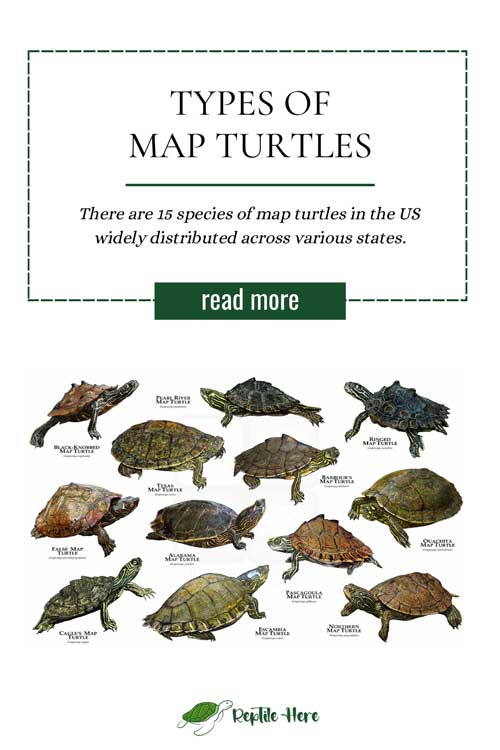Types of Map Turtles
There are 15 species of map turtles in the US widely distributed across various states. Most of these map turtles are good for keeping as pets for all levels of pet owners from beginner to experienced.
Most folks favor map turtle species for turtle pets due to their cute and unique appearance. They feature intricate contour-like patterns on their skins and shells, hence the name map turtles.
The following guide takes a closer look at the map turtles of the US. For each species of turtle, we’ll cover basics such as physical appearance, average adult size, what they eat, where they live, lifespan, and conservation status.
1. Northern Map Turtle
Contents
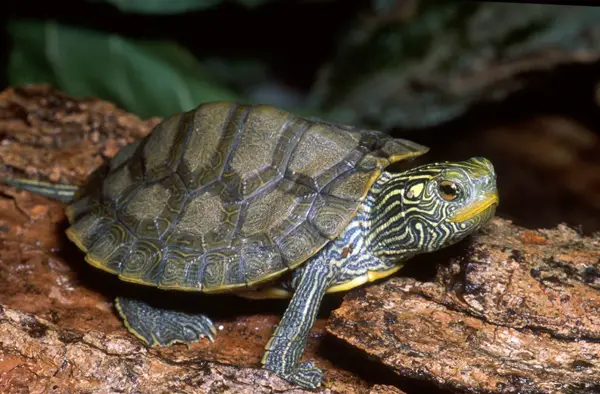
- Scientific name: Graptemys geographica
- Common name: Northern Map Turtle, Common Map Turtle
- Family: Emydidae
- Size: 3 to 10 inches
- Lifespan: 30 to 50 years
- Conservation status: Least Concern
The Northern map turtle is one of the map species that inhabit various parts of the United States.
It prefers large waterbodies with debris. These offer the perfect spots for basking while the water bodies enable the aquatic animal to spend its hibernation periods in winter completely submerged.
Like other map turtles, this common map turtle gets its name from the map-like pattern on its shell. Its shell is typically darker in color and ranges from brown to black. The map pattern has a lighter coloration.
The common map turtle is mainly carnivorous and feeds on mollusks such as clams and snails. It will also eat crayfish and insects. And when animal matter gets scarce, it will turn to plant matter.
Note that it may be difficult to spot a common map turtle in the wild. Although active during the day, these turtles are quite shy and will quickly retreat to the waters at the slightest disturbance.
2. Ouachita Map Turtle
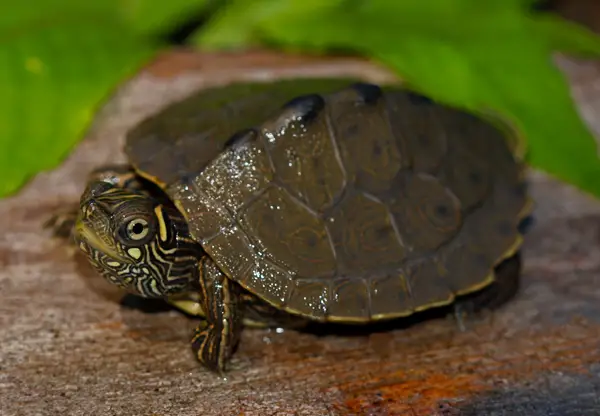
- Scientific name: Graptemys ouachitensis
- Common name: Ouachita Map Turtle, Map Turtle
- Family: Emydidae
- Size: 3 to 5 inches (males), 8 to 10 inches (females)
- Lifespan: 30 to 50 years
- Conservation status: Least Concern
The Ouachita map turtle is named after the river where it was discovered—Ouachita!
Ouachita turtle is medium to large in terms of size. The average adult female is 3-5 inches long while the male is 8 to 10 inches long. It features thin, yellowing lines that form a web on the turtle’s shell (similar to a contour elevation map).
Moreover, the turtle has brown to olive coloring, with a light spot under both eyes.
The easiest way to identify this turtle from other map turtle subspecies is by checking the dots on its face. They usually have 3 prominent spots—under the jawline, under the eye, and behind the eye.
Note that this turtle prefers living in stagnant or slow-moving waters, including ponds, lakes, and streams.
It also prefers waters with plenty of vegetation. This species is omnivorous and eats meat, insects, vegetables, fruits, and aquatic vegetation, to name but a few.
3. False Map Turtle
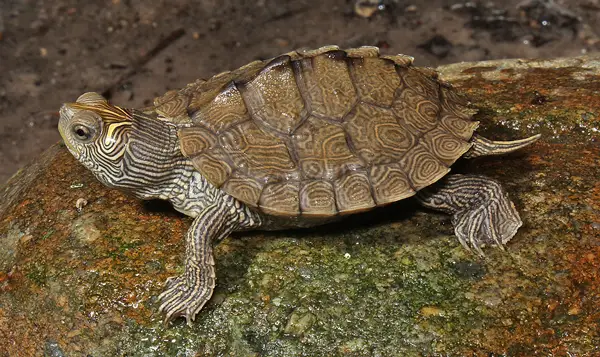
- Scientific name: Graptemys pseudogeographica
- Common name: False Map Turtle, Sawback Turtle
- Family: Emydidae
- Size: 6 to 10 inches (females), 3.5 to 6 inches (males)
- Lifespan: 30 to 50 years
- Conservation status: Least Concern
The False map turtle is another turtle species that live in rivers, streams, oxbow lakes, and river systems. It is an excellent swimmer and prefers moderate currents and deep waters.
Its upper shell coloring ranges from olive to dark brown, with light-colored lines on its limbs. It also features a line behind its eye that forms a backward “L” shape. The map pattern on its carapace tends to fade as the turtle ages.
Since this map turtle is omnivorous, it feeds on aquatic insects and animals as well as vegetation. It is fond of river snails and crustaceans. Don’t forget it has strong jaws and can give a nasty bite!
Like other aquatic turtles, this map turtle spends most of its waking hours sunning.
The false map turtle is quite shy and quietly and swiftly slides into the water at the slightest signs of disturbance. It likes spending most of its time in water and is most active in climate conditions of over 85 degrees Fahrenheit.
4. Barbour’s map turtle

- Scientific name: Graptemys barbouri
- Common name: Barbour Map Turtle, Barbour’s Sawback Turtle
- Family: Emydidae
- Size: 3 to 5 inches (males), 8 to 10 inches (females)
- Lifespan: 30 to 50 years
- Conservation status: Least Concern
The Barbour’s map turtle species is confined to the states of Georgia, Alabama, and Florida.
Since these turtles are highly nervous, you’re cautioned against handling or approaching them if you see them in the wild. When started, they quickly burrow into the bottom of a waterbody or mud.
Barbour’s map turtle has dark brown or black skin covered with yellow to green markings. And on the upper part of their shell lays the spines—their most distinct feature. Though these spines may vary in size from one turtle to another, they all have got dark tips.
Females are usually larger than females. The females’ heads are way larger compared to those of their male counterparts.
The Barbour’s map turtle prefers living in slow-moving or stagnant lakes, ponds, or streams with a lot of aquatic vegetation. It is omnivorous and feeds on insects and aquatic vegetation.
5. Escambia map turtle
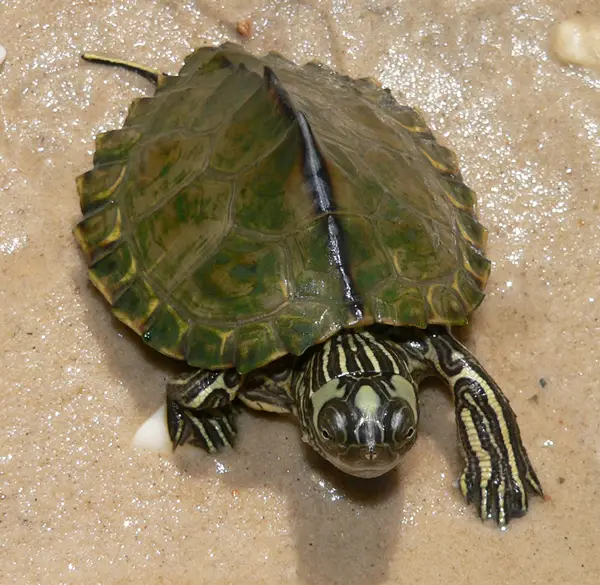
- Scientific name: Graptemys ernsti
- Common name: Map Turtle
- Family: Emydidae
- Size: 3 to 5 inches (males), 8 to 10 inches (females)
- Lifespan: 30 to 50 years
- Conservation status: Least Concern
The Escambia Map Turtle inhabits large rivers in Georgia and Alabama. It gets its name from the fact that it is only found in rivers that drain into Escambia Bay.
This map turtle subspecies has a brown-colored shell with a black pronounced vertebral keel. The skin is usually black and comes covered with white-yellow or white lines. And big white spots can easily be spotted between and behind their eyes.
Like other map turtle sub-species, these turtles also live in slow-moving or stagnant lakes, ponds, or streams with a lot of aquatic vegetation.
They’re omnivorous in nature; males prefer insects and their larvae while females are fond of clams and mussels.
It is also interesting to note that these turtles are closely related to the Barbour’s Map Turtle species. The two species even cross-breed where they have their ranges overlapping.
6. Yellow-blotched map turtle
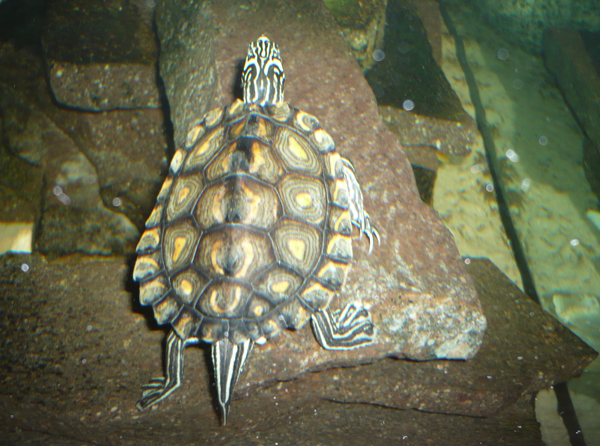
- Scientific name: Graptemys flavimaculata
- Common name: Yellow-blotched Sawback
- Family: Emydidae
- Size: 3.5 to 7.5 inches
- Lifespan: 30 to 50 years
- Conservation status: Endangered
The Yellow-blotched Map Turtle is only found in Mississippi (in Mississippi’s Pascagoula River). It has also been observed in the Escatawpa river.
A Mississippi Yellow-blotched Map Turtle is identified by a green to olive upper shell, with yellow scutes at the center of most of its scutes.
It has a central ridge of prominent keels extending from shell spine. Note that the central keel in this species is the largest that has even been observed in all map turtle species.
Like the other species of map turtles, this Pascagoula map turtle of Mississippi is omnivorous. It mostly feeds on insects, crustaceans, and aquatic plants.
Don’t forget that this turtle is labeled as an endangered species in the US and is under special monitoring.
7. Pascagoula map turtle
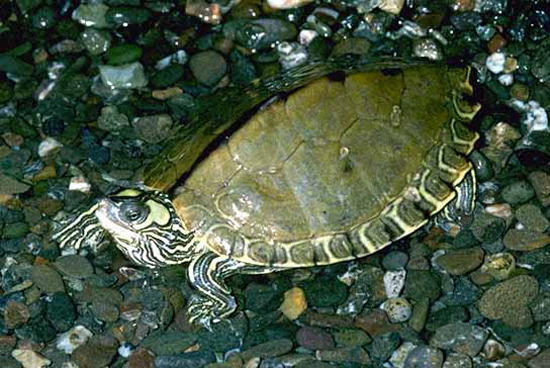
- Scientific name: Graptemys gibbonsi
- Common name: Pascagoula Map Turtle, Pascagoula Sawback
- Family: Emydidae
- Size: 5 to 11.5 inches
- Lifespan: 30 to 50 years
- Conservation status: Endangered
Like the yellow-blotched map turtle above, this map turtle is also found in Mississippi state only.
It is native to the Pascagoula River, situated in Mississippi’s southeastern regions. It gets its name from Whit Gibbons, an American herpetologist.
Due to its restricted habitat, this turtle is classified as endangered and is under special monitoring by the relevant authorities in Mississippi.
The Pascagoula is identified by a brown to olive shell with protruding keels. It also features yellow stripe markings around its scutes, at the edge of the shell. Both its head and skin are olive with yellowish spots and stripes.
Like the other species of map turtles, this Pascagoula map turtle of Mississippi is omnivorous. It mostly feeds on insects, crustaceans, and aquatic plants.
8. Black-knobbed map turtle
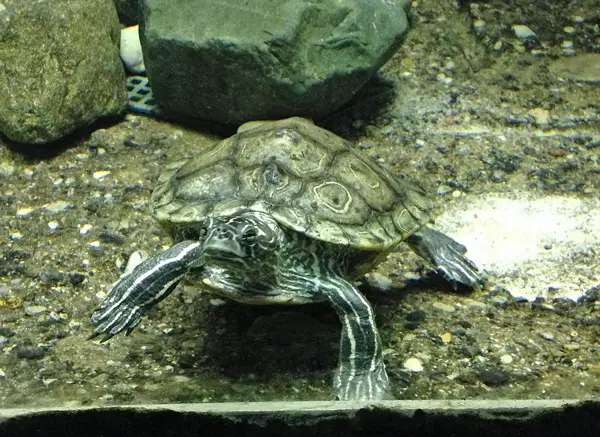
- Scientific name: Graptemys migrinoda
- Common name: Black-knobbed Sawback
- Family: Emydidae
- Size: 3 to 5 inches (males), 8 to 10 inches (females)
- Lifespan: 30 to 50 years
- Conservation status: Least Concern
The black-knobbed map turtle is found in the Mobile Bay drainage system of Alabama and also in Mississippi.
This medium-sized aquatic turtle species is small to medium-sized and is easily identifiable by black knobs/spines along the middle of its back.
In terms of coloration, this species usually has a dark olive upper shell and a pattern that resembles a map, making it a subspecies of map turtles.
And the lower side of its shell features yellow and dark-colored patterns. Its skin is usually black with yellow-colored stripes.
Like the other map turtle species, the black-knobbed map turtle prefers living in slow-moving or stagnant lakes, ponds, or streams with a lot of aquatic vegetation.
They’re omnivorous and feed on meat, insects, vegetables, fruits, aquatic vegetation, etc.
9. Ringed map turtle
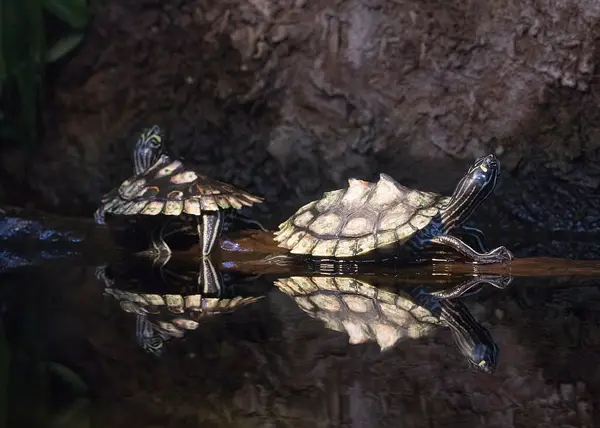
- Scientific name: Graptemys oculifera
- Common name: Ringed Map Turtle, Ringed Sawback
- Family: Emydidae
- Size: 3 to 5 inches (males), 8 to 10 inches (females)
- Lifespan: 30 to 50 years
- Conservation status: Vulnerable
This map turtle shares a range with the Pearl River Map Turtles and is found in Pearl River system in Louisiana and Mississippi states.
In the state of Mississippi, this turtle is mainly concentrated in several eastern counties near Pearl River.
You can easily identify a ring map turtle by looking at its shell. It features prominent light circles on a dark shell background—this is where it gets the name “Ringed” turtle.
The shell color ranges from green to yellowish, with some sharp peaks situated down the center. Also, their shells feature jagged, saw-tooth edges.
This ringed map turtle is omnivorous and loves eating crustaceans, mollusks, and aquatic vegetation. It prefers living in moving waters such as rivers.
10. Pearl River Map Turtle

- Scientific name: Graptemys Pearlensis
- Common name: Pearl River Map Turtle
- Family: Emydidae
- Size: 3 to 5 inches (males), 8 to 10 inches (females)
- Lifespan: 30 to 50 years
- Conservation status: Endangered
The Pearl River Map Turtle is native to Pearl River system in Louisiana and Mississippi, hence its name. This rare sub-species of map turtle is native to the Southern United States.
Its upper shell is olive green and features fluted edges with yellow markings. The female usually has a larger head and a flattened, wide beak for crushing food.
Note that it is usually a challenge to tell apart this turtle from some of its close map turtle cousins.
Like the other map turtles, the females are usually larger than the males.
Pearl River Map Turtles are omnivorous and mainly feed on crustacean invertebrates, small fish, and aquatic plants.
Unfortunately, this turtle species is under threat from water pollution and has been labeled as endangered species due to its declining population.
11. Alabama map turtle
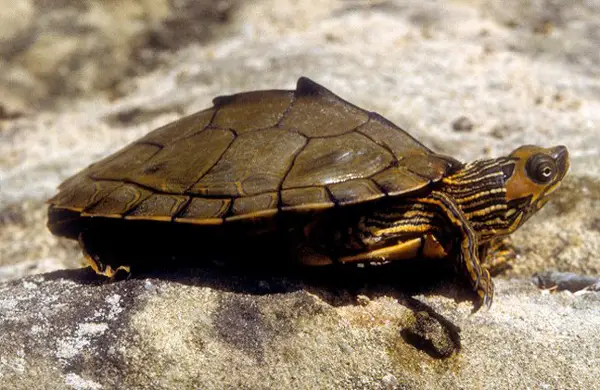
- Scientific name: Graptemys pulchra
- Common name: Alabama Map Turtle, Sawback
- Family: Emydidae
- Size: 3.5 to 5.25 inches (males), 7 to 11.5 inches (females)
- Lifespan: 50+ years
- Conservation status: Near threatened
This species of turtle is found in Mobile Bay Drainage System in Alabama, hence the name Alabama map turtle. It is found in only 3 states namely Alabama, Georgia, and Mississippi.
It is easily identifiable by a spiny black line that runs down the middle of its shell. They get the name “map” from the map-like markings on their shell back.
The Alabama turtles are medium-sized (though males are smaller than females) and are pretty shy. They’re known to slip into the water in case of any disturbance or danger. Their carapace is usually brown with faint yellow, orange, or green markings.
Juveniles are usually bright-colored, but their coloration tends to fade over time. The spiny back of these turtles also tends to wear as they age, especially for adult females.
These Alabama map turtles are omnivorous, and their diet mainly consists of aquatic plants. However, they also feed on insects, small fish, tadpoles, and even worms.
Alabama map turtles are mainly found in shallow and highly vegetated waters, including ponds and rivers. They can also be found in fast-moving creeks featuring rocky bottoms.
12. Cagle’s Map Turtle
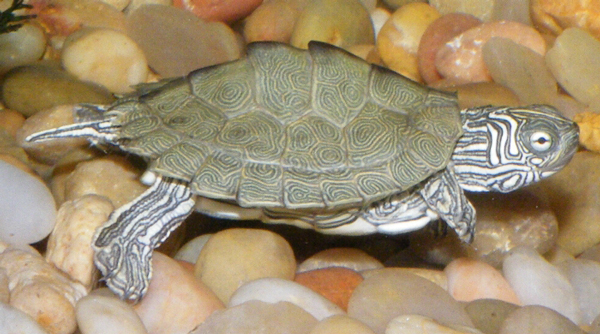
- Scientific name: Graptemys caglei
- Common name: Cagle’s Map Turtle
- Family: Emydidae
- Size: 8 to 10 inches (females), 3 to 5 inches (males)
- Lifespan: 3o to 50 years
- Conservation status: Least Concern
The Cagle’s map turtle is native to Texas. However, it has a pretty small population and is only found in Guadalupe River System in southern Texas.
It gets its name from herpetologist Dr. Fred Ray Cagle. It is somewhat similar to other map turtles in that it has a dark shell with steep keels and serrated rears. It also has cream to yellowish spots on its head.
Cagle’s map turtle of Texas is omnivorous, just like other map turtles. It feeds on mollusks, insects, and (occasionally) vegetation.
This is an endangered species and is under protection by Texas regulations.
Nonetheless, the turtle still finds its way to the pet markets. This is due to its small size, eye-pleasing green coloring and ease of care—these traits are quite rare among the map turtles.
13. Mississippi Map Turtle

- Scientific name: Graptemys pseudogeographica kohni
- Common name: Mississippi Map Turtle, Sawback turtle
- Family: Emydidae
- Size: 3 to 10 inches
- Lifespan: 30 to 50 years
- Conservation status: Least Concern
The False map turtle is another turtle species found in Wisconsin, Mississippi, Iowa, Arkansas, Tennessee, Minnesota, Missouri, Louisiana, and Kentucky.
This turtle’s preferred habitat includes rivers, streams, and oxbow lakes of the Missouri and Mississippi and other river systems.
It is an excellent swimmer and prefers moderate currents and deep waters.
Its upper shell coloring ranges from olive to dark brown, with light-colored lines on its limbs. It also features a line behind its eye that forms a backward “L” shape. The map pattern on its carapace tends to fade as the turtle ages.
Since this map turtle is omnivorous, it feeds on aquatic insects and animals as well as vegetation. It is fond of river snails and crustaceans. Don’t forget it has strong jaws and can give a nasty bite!
14. Texas Map Turtle
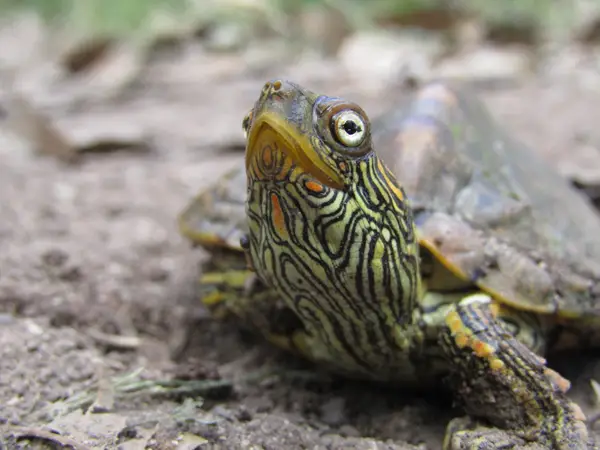
- Scientific name: Graptemys versa
- Common name: Texas Map Turtle
- Family: Emydidae
- Size: 3 to 5 inches
- Lifespan: 3o to 40 years
- Conservation status: Least Concern
This is a relatively smaller subspecies of map turtles endemic to Texas state. It is mainly concentrated in the central regions flanking Colorado river. It can also be found in Concho and Llano river systems.
It prefers living in faster-moving waterbodies. Although it basks regularly, it rarely strays far from the waters. It is an excellent swimmer and even when nesting, it will not go farther than 10 ft. from its pond.
The Texas map turtle’s shell varies from olive to brown and is covered with yellow patterns—just like the contours of a map. Moreover, this turtle has easily visible spiked keels.
A series of 3 yellow to orange spots along the bottom of its head distinguishes this turtle from other map turtle species. The omnivorous turtle feeds on plants, aquatic invertebrates, and insects.
15. Sabine Map Turtle
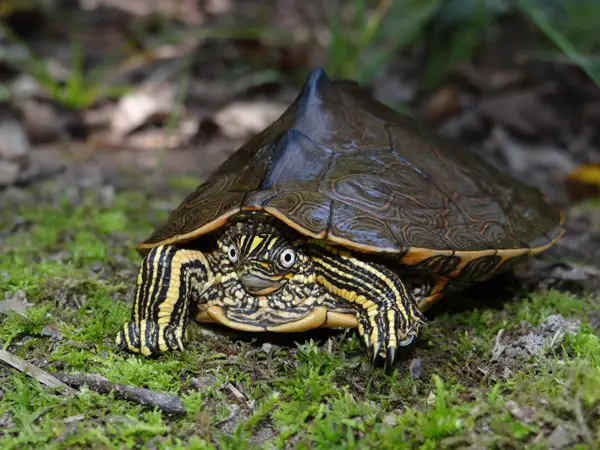
- Scientific name: Graptemys sabinensis
- Common name: Sabine Map Turtle
- Family: Emydidae
- Size: 3 to 5 inches (males), 8 to 10 inches (females)
- Lifespan: 30 to 50 years
- Conservation status: Least Concern
The Sabine Map Turtle inhabits Texas and Louisiana states. It is an extremely close relative of the Ouachita map turtle. They’re quite identical in terms of behavior and looks.
In fact, it has always been considered a sub-species of Ouachita turtle until recently.
The only difference is that this Sabine map turtle has a pretty smaller range and is only found in a few river systems in Texas and Louisiana.
Sabine map turtle has an olive or brown upper shell, with rounded lumps forming a ridge at the center of its back. Black horizontal lines can be seen in its eyes running across white irises.
The face sports yellowish markings while the lower side of its lower shell side has a yellow-to-cream coloration.
Just like the other map turtles, this Sabine map turtle is omnivorous and feeds on crustaceans, mollusks, small fish, and aquatic plants.
Conclusion
Now you know the various species of map turtles inhabiting the US. Map turtles are a favorite for most people for keeping as pet turtles. This is due to their cute and unique appearance with map-like patterns covering their skins and shells.
The Texas map turtle and Mississippi map turtles are the most popular in the turtle pet market. They’re not only visually appealing but also fairly small in size, making them easy to care for and maintain.
